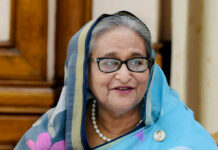Offices, shops in downtown Dhaka burnt, looted; 3 dead; over 200 hurt

Bangladesh has seldom experienced brute violence of this scale. Several parts in downtown Dhaka now resemble a burned-out and looted zone.
Thousands of radical Hefajat-e Islam men, instigated and bolstered by Jamaat-Shibir activists, exploded into an awe-striking force and set fire to hundreds of shops and police outposts as the evening descended.
Dhaka’s night skyline turned orange, as flames leaped from burning establishments after power supply was cut off. The Hefajat men forced into a parking lot at Dilkusha area and torched at least 50 government buses.
The affected areas were rocked with loud explosion of bombs set off by Hefajat and Jamaat men, while police rained thousands of teargas shells and rubber bullets on the marauding Islamists.
As police and Hefajat men fought on the streets — from Paltan to Bangabandhu Avenue, and from Motijheel to Bailey Road — at least three people were killed in the violence.
A few thousand shops, including jewellery, electronics and furniture outlets, were looted at Paltan, Baitul Mukarram and stadium markets.
Hefajat had earlier promised to hold a non-violent rally at Shapla Chattar to protest what it called anti-religion write-ups by “atheist bloggers” and press home its 13-point charter of demands, including introduction of a blasphemy law.
But it eventually turned nasty after police tried to block a procession of Shibir men at Nayapaltan around 11:30am.
The clash there soon spread to Bangabandhu Avenue, as Shibir and Hefajat men tried to attack the Awami League office there around 1:30pm.
Violence broke out in the Paltan area, and the office of the deputy Commissioner (traffic) was set ablaze.
The government issued a warning to the Hefajat men that they either leave the capital immediately or face stern action. But the zealots ignored it and vowed to stay put.
As their Dhaka siege programme was over, Hefajat men started marching towards Motijheel for attending the rally. Wielding sticks, thousands of men in white robes converged in Motijheel by the afternoon.
CAPITAL TURNS BATTLEGROUND
Large parts of the capital, including Purana Paltan, Baitul Mukarram, Bijoy Nagar, Dainik Bangla intersection, Bangabandhu Avenue and Motijheel turned into battle ground during the mayhem that began in the morning.
Two of the dead were identified as Siddiqur Rahman, 28, a worker of Hanif Paribahan, and Mohammad Nahid, 21, an employee of a shop in Baitul Mukarram area.
The identity of the other victim could not be known.
Meanwhile, a branch manager of an insurance company died of cardiac arrest while trying to escape the violence in Motijheel area.
Kamaluddin Khan, 55, of Desh General Insurance, was on the way home from his workplace in Motijheel in the evening.
Hefajat men vandalised more than 150 vehicles, including 50 buses of the public administration ministry, and set fire to 30 of those at Rajuk Avenue.
At least 10 vehicles were set ablaze last night in Sukrabad, Dhanmondi, Dolaikhal, Sadarghat, Uttara, Malibagh, and Tejgaon industrial area in the capital and two places in Gazipur.
They also torched 100 shops and business establishments in Bijoy Nagar and Paltan areas, and looted shops in Baitul Mukarram market last evening.
The Islamists also set fire to the deputy commissioner’s (traffic-east) office, showroom of Ideal products and office of the Communist Party of Bangladesh (CPB), smashed windows of most of the offices on both sides of the roads from Dainik Bangla intersection to Janata Bank intersection.
More than 5,000 rounds of rubber bullet, teargas canisters and bullet were fired during the clashes, said police.
The clashes followed the explosion of a crude bomb at Paltan around 11:30am, hours before the Hefajat rally began in Motijheel.
More than 200 people were injured in the violence.
Several hundred Hefajat men tried to march towards Gonojagoron Mancha in Shahbagh defying police barricades, said Sheikh Maruf Hasan, deputy commissioner of Dhaka Metropolitan Police (Ramna Division).
When police barred them, they got into scuffles with law enforcers, he said.
Attacks on AL office
Thousands of Hefajat men aided by Shibir activists swooped on the roadside shops in front of Awami League’s central office around 2:30pm.
As the AL men and police tried to resist them, they attacked the AL office. At one stage, police fired bullets from shotguns. Siddiqur, a worker of Hanif Paribahan, sustained severe bullet wounds during the clash.
He was rushed to Dhaka Medical College Hospital where doctors declared him dead.
The doctors said more than 100 injured people, including five police men, were taken to the hospital. Most of them were hit by bullets.
A traffic constable sustained severe burns when Hefajat men set fire to a police box at Bijoy Nagar. The radical Islamists also beat up a constable near Paltan intersection.
During the clashes with police, Hefajat and Shibir activists set off hundreds of cocktails, creating panic among the commuters.
Many people remained stranded in their offices in Motijheel and Paltan areas following the clashes. Electricity supply was cut off in the two areas last night.
The Hefajat men attacked several TV cameramen, including Mohammad Nasir Uddin of Mohana Television, while they were taking video footage of their vandalism.
They also assaulted several journalists, including a female reporter, and torched the toll collection booth on Babubazar bridge in old Dhaka in the evening.
Talking to reporters at his office yesterday noon, Home Minster Muhiuddin Khan Alamgir said Jamaat-Shibir activists mingled with the Hefajat men resorted to violence during Hefajat’s Dhaka blockade programme.
“Hefajat leaders kept constant contact with me. They said no Hefajat men indulged in violence, rather it was Jamaat-Shibir men who, in the guise of them, created anarchy,” said the minister.
Source: The Daily Star









